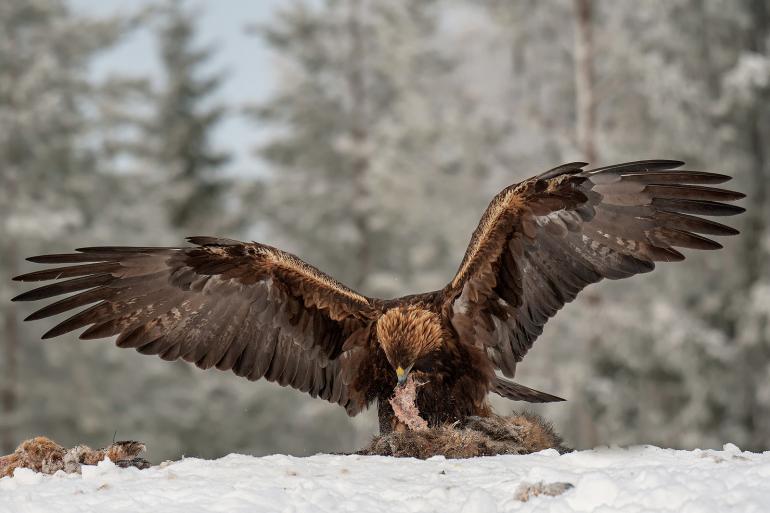Clean Kill
Protecting raptors with non-lead ammo.
They came flapping from under the drooping limbs of a large fir tree, scaring the bejesus out of a friend and me. I’d killed a mule-deer buck the previous evening; we’d pulled it under the branches for the night, and had returned in the morning to retrieve it. But two golden eagles had found it first. They barely cleared the knitted hat on my head and flew clumsily down a steep draw instead of soaring into the heavens. In minutes, we knew why. Not only had the birds cleaned up most of the gut-pile; they’d also consumed a large quantity of the deer’s rear quarters and were so full they could hardly fly.
Both golden and bald eagles are prone to scavenge offal and other carcass parts of big-game animals taken by hunters. Unfortunately, they often get more than a meal of meat—fragments of lead from expanding bullets are commonly found in the bounty as well. While cleaning up the leftovers, eagles may ingest fatal amounts of lead.
Vince Slabe, an eagle researcher, recently completed a massive study of bald and golden eagles all across the United States. His project involved around 1,200 birds, including over 200 samples from Montana. Nearly half of the birds surveyed showed signs of repeated lead poisoning. The study also confirmed the findings of previous research with eagles: lead levels are generally highest during the fall and winter, a direct result of these magnificent birds scavenging on the remains of animals killed by hunters.
There’s a simple way hunters can effectively alter the “scavenging equals lead poisoning” equation for eagles: switch to non-lead ammunition. Available for most widely-used hunting cartridges such as the .270, 300 Win Mag, and 6.5 Creedmoor, non-lead ammo is composed of copper alloys, and is just as deadly in the rifle of a competent hunter as its leaded counterparts. I tried some at the request of a Federal Cartridge representative around 20 years ago and have since used copper ammunition from all of the major cartridge companies. The bullets expand consistently and penetrate deeply, exactly the characteristics needed for a quick, humane kill on the deer and elk commonly targeted by Montana hunters. Since its early days, copper ammunition has been known for its accuracy in all calibers.
There’s another powerful reason for hunters to use non-lead ammunition: death by lead poisoning is neither swift nor painless.
As a practical outgrowth of his research, Slabe is promoting a project funded by AMB West Philanthropies and the American Eagle Foundation to get more non-toxic ammunition into the hands of hunters. For the upcoming season, hunters can receive a $20 voucher good toward one box of non-lead ammunition at several Bozeman-area sporting goods store (visit montanahuntersforeagleconservation.org for details). Priority will be given to residents of Gallatin, Madison, Park, and Sweet Grass counties. According to Slabe, the Emigrant-based AMB West “prefers to fund conservation efforts in its own back yard.” If excess vouchers are available, the program may be opened to all Montana hunters.
Hunters’ ammunition choices directly affect eagle conservation and welfare. Slabe’s research indicates bald-eagle populations may be suppressed by about 4% due to lead poisoning; it’s around 1% for golden eagles. These may seem like small percentages and are probably inconsequential for the nation’s growing bald-eagle population. But in the case of golden eagles, whose population is not growing, “even a 1% reduction in the growth rate could be the difference between a stable population and a declining population.”
There’s another powerful reason for hunters to use non-lead ammunition: death by lead poisoning is neither swift nor painless. “Lead attacks basically all of the bodily systems, including the nervous system,” explains Slabe. “It eventually compromises motor skills so that eagles cannot successfully feed or fly. The digestive system can also shut down.” In short, lead poisoning results in a nasty process of starvation.
In addition to eagles, lots of other animals that scavenge on the byproducts of hunting are suscptible to lead poisoning, including various raptors, canines, and bears. Our nation switched to unleaded gasoline in our automobiles decades ago to create a healthier environment for humans. For eagles and other wildlife, hunters can make a similar transition to non-leaded ammunition. Thanks to the newly-launched voucher program, Bozeman-area outdoor folks can go unleaded on a budget.














